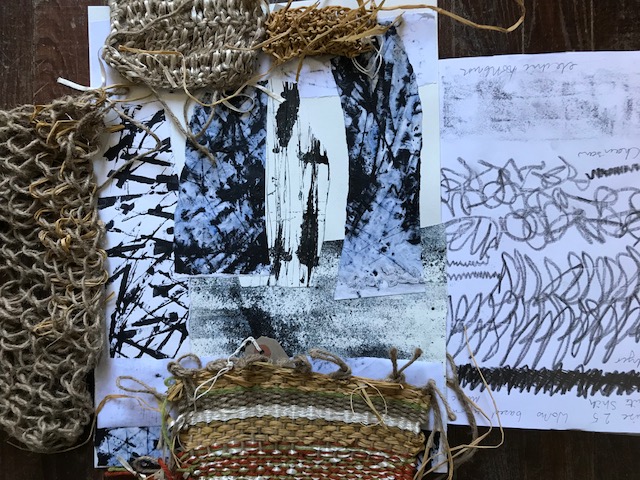Scratched
I chose this group because I think it is the cohesive and answers the questions in the brief most fully. When I reviewed the groups all together it was the one that my eye was drawn to first. I also felt I hadn’t confused things by putting too many different items in – there was a temptation when grouping to include too much which led to dilution and to too many threads leading on.
The group is a mixture of paper and crafted elements. The woven and knitted elements reflect the patterns, shapes and textures of the drawn and printed ones, although they were produced with different inspirations. The sketchbook page on the right was made for Exercise 2.5 in response to sounds, (from top to bottom, hairdryer, chainsaw and electric toothbrush). In fact, the rhythm of the chain-saw inspired marks is similar to how rhythmic knit stitches look. The collage of papers in the centre and at the back (made with ink and paint, and using damp and dry paper, plastic card, brush handles, charcoal grated on gesso etc. etc.) from the mark making exercise 2.6 is abstract and was intending to juxtapose marks and textures. The collage has both hard and soft marks, some are mesh-like, as knitting and weaving are. The bottom and top strips was made by printing a piece of embroidery onto damp papers, producing blurred but visibly floral shapes.
The woven, knitted and crocheted samples from Assignment 3 are varied although have the same string base. The scratchy string is hard-wearing and rough, but the woven sample, surprisingly flexible because of the thick strands of the warp, has contrasting silk yarn (cream, providing an interesting contrast to ‘scratched’) and a thin line of green wool which stands out against the string despite being a soft hue. The knitted sample has a small strand of raffia knitted in to one row and the size of needle (20 mm) and type of yarn made for a light, airy, rather formless and flexible sample. The crocheted sample was the first one completed, and is from the same ball of string, but the smaller 6 mm hook and double crochet stitch have produced a dense, thick, unyielding fabric, rather like matting.
Reviewing the questions.
These items alone are not that interesting but together as a group they excite me because they seem to speak to each other. There are repeated motifs and forms, and others that reflect or answer. This is fascinating because some are flat marks on paper and some are crafted in 3D. The processes of weaving, crochet and knit drew me the most (as I’ve already explained) and interestingly the mark making exercises were absorbing (how many different marks had to be made to produce the variety required) and freer than trying to draw objects, for example.
I can see a new colour palette emerging, which is a base of string-brown, with different greys and a silky cream, and accents of dark orange, green and ochre. As to theme, I need to work through some idea in my sketchbook before making a decision.
Returning to the body of work, I decided to choose another sample that brings together some of the others.

Next I re-photographed the group, to bring out these new relationships.





exiting – I can see how access to all you samples have helped you.
LikeLike
This makes a lot of sense, Sheena. I love the way your mark making and textiles construction come together to make something with such potential – like there’s some subconscious process or serendipity in action here.
LikeLike